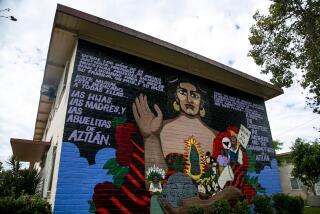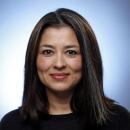Remembering the Chicano arts collectives of Highland Park
- Share via
They were bold enough to call it a revolution.
Back in the 1970s, when Chicano art was synonymous with East Los Angeles, its storied murals and its art center, Self-Help Graphics, a group of Mexican American artists decided to break away.
They headed north, seven miles, to start their own Chicano arts collective in Highland Park, an area that was still mostly white with little presence of Latino art.
“Our mission was to transform Highland Park into a super-revolutionary Chicano town,” said artist Richard Duardo. “I drank the Kool-Aid. We all drank the Kool-Aid.”
For about four years, the group set up an arts colony on the second floor of an old music building on North Figueroa Street. They printed an art magazine, created murals, paintings and silk-screen posters that became a part of the Chicano art movement — iconic political, social and cultural images.
Their legacy lives on in Highland Park’s Avenue 50 Studio, a Chicano art gallery co-founded by Roberto Delgado, an artist involved with the movement.
Ten years ago he had the idea to showcase the story of the Chicano artists in Highland Park, and on Saturday it will finally be told.
Their work will be on display through Feb. 5 in an exhibit called “Resurrected Histories: Voices from the Chicano Arts Collectives of Highland Park.” The gallery will also preview a one-hour documentary on the group, put together with grants and in partnership with KCET-TV.
“We felt this was an exciting story to uncover,” said Kathy Gallegos, gallery director. “It was like an archaeological dig that let us understand who all was involved and how much they did while they were here.”
The exhibit offers a look at all the Chicano art groups that sprouted in California four decades ago and how they were connected. They formed clusters in Fresno, San Francisco, San Diego and Los Angeles that supported one another at a time when Chicano art had no place in mainstream museums or galleries.
In Highland Park, two collectives came about in the mid-1970s. Both migrated from East L.A. in search of cheaper rent.
Mechicano Art Center, a nonprofit supported by grants to nurture art in the community, set up shop on North Figueroa, in a corner building that’s now a produce market. It held exhibits, painted murals around the city and worked with local high school students.
“We were passionate about our work,” said artist Sonya Fe. “The kids would come up with ideas, we’d have parties and we’d have fundraisers.”
Down the street, in the old music building, Duardo and a handful of Chicano artists rented a 5,000-square-foot space for $300 a month. They called it Centro de Arte Publico, or the Center for Public Art.
Many were in their 20s and 30s, liberal college graduates with art degrees, and motivated by social injustices to express themselves through art.
They played lots of reggae, talked politics and took on a whole series of projects in the city, such as murals, picket signs for students organizing walk-outs, and posters supporting the then-revolutionary Sandinista socialist political party in Nicaragua.
To pay the bills, they did commercial work: signs for grocery stores, theaters and Realtors.
“The idea was to not depend on anyone — not grants or the government,” said artist John Valadez. “We wanted to support ourselves with our own art.”
Neighbors in the area never knew much about the Center for Public Art. They’d only see paintings and posters displayed on the windows of the building. Once, Carlos Almaraz, the most political of the bunch, hung a bright red flag of communist China and caused a stir on the block.
By 1980, the artists began to go their separate ways and the collective dissolved. Some married, moved away or relocated to downtown L.A., where an art scene was picking up momentum.
Many are now in the 50s and 60s, their work featured in galleries and museums across Los Angeles.
“It’s good for people to know what we’ve done to influence art across L.A. and in the world,” Delgado said. “I hope it connects us more.”
More to Read
Sign up for Essential California
The most important California stories and recommendations in your inbox every morning.
You may occasionally receive promotional content from the Los Angeles Times.











